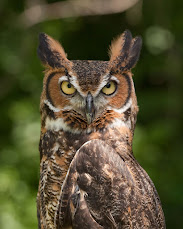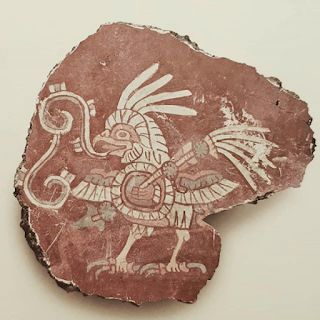 |
| "The owls are not what they seem" |
On this blog I often write about topics that are somewhat speculative, such as patterns I've noticed and which seem to be suggestive of something interesting but which may fall short of establishing it as a fact.
A year ago, in this blogpost, I wrote about evidence suggestive of an Uto-Aztecan, but non-Nahuan (or pre-Nahuan rather), language being spoken at Teotihuacan. The juxtaposition of ears and nopal pads in a Teotihuacan mural, which could be read as a hint of a name - perhaps related to the Huichol goddess Nakawe. This blog post takes a similar path: I've noticed some patterns in two Uto-Aztecan languages, that are particularly suggestive when juxtaposed with an element of Teotihuacan iconography.
The pattern I will describe is just this, suggestive, but it is hard to say exactly what it might mean, or how it would have come about. I noticed it as part of my work comparing the various Southern Uto-Aztecan languages (SUA) to build a database of shared lexicon between them. I include the Hopi language of Arizona in this comparison, not because Hopi is a Southern Uto-Aztecan languages (it belongs to the northern group) because of the cultural similarities between Hopi and the Southern languages (Hopi is the only one of the Northern languages in which maize agriculture is a culturally central activity) and because it seems likely that Hopis may historically have been in contact with Southern Uto-Aztecans from Mexico who traded luxury goods (such as parrots and cacao) to the US Southwest.
The way I work is reading through dictionaries and noting all the words that look like they might be cognate to words in some other SUA language. This requires paying attention to patterns of sound and meaning, between languages and across dictionaries. Sometimes patterns are simple, like this one, with simple and perfect correspondences between sound and meaning in two or more languages:
"give" "nose "human
Nahuatl ma:ka yaka tla:ka-tl
Hopi maqa yaqa taqa
Sometimes (often) they are more complex, involving changes in meaning and sound changes that do not conform to the expected patterns or simple correspondences, obscured by subsequent divergent changes or combinations with other morphemes.
The correspondence I will show here is odd, in that the pattern does not involve words that are cognate between languages, but distinct words that *sound* similar in each language - seemingly creating a "pun" in both languages- but without using the same or related words. Here is the basic pattern this blog post is about:
Hopi Nahuatl mongwu /mungʷɨ/ - "owl“ tecolotl /tekolotl/ “owl” mongwi /mungwi/ - "leader“ tecuhtli /tekʷtli/ “lord/leader”
Below I analyze each of the word sets and their related words in other SUA languages. I use the term "pre-Nahua" to describe the Southern Uto-Aztecan dialectgroup that turned into proto-Nahuatl - I believe that this pre-Nahua language was a sister dialect to proto-Corachol and had derived from a common proto-Corachol-Nahua stage, but in the following I do not distinguish between pre-Nahua and proto-Corachol-Nahua since this would require a more detailed chronology, so pre-Nahua is just whatever is between proto-Southern Uto-Aztecan and proto-Nahuatl.
Owl/Chief in Hopi and owl/death in other languages
 |
| Great Horned owl (Bubo virginianus) |
- mongwu /mungʷɨ/ - "great horned owl" (Hopi dictionary, 1998:248 )
- mongwi /mungʷi/ - "leader, head, chief" (Hopi Dictionary 1998:247)
Ken Hill assigns the two to two distinct Uto-Aztecan etymologies *mu "head" (Hill 2020:276) and *muu 'owl' (Hill 2020:275) (For example Mayo mu'uu "owl", Eudeve muhút 'owl'). It seems likely that the word *muu for owl is a sound mimicking name for the owl, and that the word for head is unrelated. This would suggest that the similarity between the two Hopi words is simply coincidental.
In many indigenous American cultures the owl is a creature of bad omen, related to the realm of the dead. Nevertheless, it is probably also coincidental that the word for 'to die' in Uto-Aztecan languages also sounds somewhat similar. In Hopi it is mooki /muuki/ "to die", in Nahuatl miki, in Huichol /mɨkí/ and in Mayo /muuke/. Nevertheless it must have added to the owl's eeriness that its voice sounding muuu in the night could almost be heard as if trying to sing "die, die". The owl as a being of the night, of course is seen as one who can travel between the human world and the underworld - a harbinger of death and bad news.
In Nahuatl one word for 'owl' (though quite rare) is cuamomohtli, and the momohtli part seems potentially related to the same root *muu (cua- is probably just tree, though it could also be 'head') - but it could also be related to the word for fear or scary which in many Nahua varieties is mowi (changed from a previous mawi), which shortens to moh- . The /u/ in Mayo and Hopi (written o in Hopi orthography) and the ɨ in Huichol is expected to yield either i or e in Nahuan, but sometimes it corresponds to o when adjacent to a labial consonant (such as m, or p or w).
In Huichol the term for owl is /míikɨri/ which looks like a potential cognate, except that the first vowel /i/ does not fit - it should be ɨ (or u).
When looking at this root, Hopi is alone among these languages in having similar, though apparently unrelated, words for 'leader' and 'owl'.
'Owl' and 'lord' in Nahuatl
 |
| Flammulated owl (Psiloscops flammeolus) |
- tecuhtli /te:kʷtli/ 'lord'
- tecolotl /tekolotl/ 'owl'
The words are less supercifially similar than the two Hopi words - but there are reasons to consider them more similar.
One such reason, is that in many contemporary Nahua varieties the root for chief or lord is pronounced [te:koh] when appearng in the possessed form (forexample Pochutec notekú "mi padre", Hueyapan Nahuatl i:te:goh "it's owner" tote:goh "Our Lord") This is often considered to be a contraction of /tekʷ-yoh/ where the -yoh suffix is the marker of inalienable possession. This may well be the case, but it is also possible that the -oh ending conserves the vowel that developed into the labialized k. Eudeve <tecogua> /tekowa/ "owner" suggests that te:kʷtli could have developed by syncope of the a so tekowatɨ became tekowtɨ which then became te:kʷtli in the non-possessed form but -te:koh in the possessed form. This also fits the Cora form teekw-a'aran 'dueño/owner' where the -a'aran is the inalienably possessed suffix corresponding to Nahua -yo:tl. Following Whorf, Jane Hill (1985) suggests an origin as *tahi-ku "fire kindler" but this does not seem like a good proposal, since *tahi "fire" became tle-tl "fire" in Nahuatl, and here we have /te:-/. Here we have to prefer the conservative proposal holding the roots with taHkw- apart from the roots with teko-.
The word for 'owl' has a root that is found in many indigenous languages - it is a so-called wanderwort. In Uto-Aztecan languages the root is found in Hopi as tokori /tukuri/ 'flammulated owl', in Cora as tukurú'u 'tecolote'. Apparently Yaqui-Mayo and Eudeve changed the meaning to vulture, with Mayo tecué /tekwé/ and Eudeve teco /teko/ both meaning 'zopilote'. The root has been reconstructed as *tɨku, which fits the Nahuatl, and Eudeve forms. The forms with u in the first syllable can arise from *tɨku through regressive vowel assimilation. It is also found in non-Uto-Aztecan languages in California as tukúli in Miwok, tukuna in Chumash, hutukulu in Wappo and hutulu in Yokuts (Gursky 1967). In Mesoamerica it is also found in Otomí tɨkuru'u (Acazulco otomí) and in K'iche Maya as tukur.
We should reconstruct the following two roots for pre-Southern Uto-Aztecan then:
- *teko-(wa-tɨ) "lord" which becomes pre-Nahua *teko(w)tɨ
- *tuko-ri "owl" which becomes pre-Nahua *teko-
So also here, we see that the two roots are not etymologically related, but only look like each other because of chance. But important here is that the -wa and the -ri are suffixes that disappear in the possessed form so that the word for "my lord" and "my owl" in pre-Nahua would be complete homophones: no-teko.
The -raawɨ root: Predators, Hunters, Enemies and Leaders
*yaawɨ 'warrior, predator' (independent noun)
- Cora & Huichol: yaabi/yaawi 'coyote'
- Yaqui: yoowe 'jefe, líder'
- Nahuatl: yao:tl 'enemy, warrior' (from proto-Nahuatl *yaawi-wa-tɨ, where -wa is a historical possessive suffix)
- Hopi: nayaawi "fight' (na- is a historical reciprocal marker)
- kwaɨ-raawe 'eagle' (Huichol) from *kwahu-raawɨ "eagle-raawɨ"
- kwaɨ-ra'abe 'eagle' (Cora)
- ɨ-ra'abe 'wolf' (Cora) from *hu-raawɨ "badger?-raawɨ"
- ɨ-raawe 'wolf' (Huichol.)
- ko-yo:-tl 'coyote' (Nahuatl) from Proto-SUA *kao-yaawi "fox-raawɨ"
- kahu-lowi 'coyote' (Tubar)
- kau-yau-mari 'coyote-youth' (a deity) (Huichol)
- o:se-lo:tl 'jaguar, puma' (Nahuatl) from pre-Nahua *house-raawɨ '"feline-raawɨ" (compare with huusee 'bear' (Cora & Huichol) ousei 'jaguar' (Yaqui).)
- tsopi-lo:tl 'vulture' (Nahuatl) from pre-Nahua *tsiwipi-raawɨ "turkey-raawɨ"
In this case we could explain /tekolotl/ as coming also from *teko-raawɨ "owl-raawɨ", designating apparently a particularly fierce or predatory type of owl - or maybe an owl that is a warrior.
"Spearthrower Owl" = Warlord?
 |
| Spearthrower Owl (/tekoraawɨ/?) on a mural fragment from the Techinantitla compound at Teotihuacan |
The data suggests that there is no historical relation between the words for owl and leader in Uto-Aztecan languages: they are simply near-homonyms.
Postscriptum:
Cited texts:
- Dakin, K., 2001. Animals and vegetables, Uto-Aztecan noun derivation. In Historical Linguistics 1999: Selected papers from the 14th International Conference on Historical Linguistics, Vancouver, 9 13 August 1999 (Vol. 215, p. 105). John Benjamins Publishing.
- Gursky, K.H., 1967. A Widespread Word for" Owl". International Journal of American Linguistics, 33(4), pp.328-329.
- Helmke, C. and Nielsen, J., 2021. Teotihuacan Writing:: Where are We Now?. Visible Language, 55(2).
- Hill, Jane H. 1985. "On the Etymology of Classical Nahuatl teek w-tli'Lord, Master'." International journal of American linguistics 51, no. 4: 451-453.
- Hill, K.C., 2020. Wick Miller's Uto-Aztecan Cognate Sets.
- Nielsen, J. and Helmke, C., 2008. Spearthrower owl hill: A toponym at Atetelco, Teotihuacan. Latin American Antiquity, 19(4), pp.459-474.
- Stuart, David (1998). ""The Arrival of Strangers": Teotihuacan and Tollan in Classic Maya History" (Extract of October 1996 paper). PARI Online Publications: Newsletter # 25. Precolumbian Art Research Institute.

Do you know Davletshin's paper on animal names? (Proto-Uto-Aztecans on their way to the Proto-Aztecan homeland: linguistic evidence, https://www.jolr.ru/files/(95)jlr2012-8(75-92).pdf ) He has a different take on -yo:- animal names.
SvarSletI do, his take is based on Dakin's - which I think is only partially correct. She sees almost all animal and plant names with stems ending in o as forming a single historical class, I think this can be easily shown to be wrong as a careful reconstruction of each word's history will show the final o to have a wide variety of origins. I think it is wrong of Dakin to reconstruct the -ra'aw+ suffix for noun-stems ending in -o: where it is not attested in any of the non-nahuan languages, and where there is no clear explanation of what the element going before the -o: part would be etymologically.
SletThe 'owl' word was discussed, as a Wanderwort, by Gursky (IJAL 33, 4, p. 328, Oct., 1967). He notes a similar Chukchi word for 'owl', and one can add Mapudungún tucúquere 'great horned owl'. The wide range suggests an onomatopoeia, but in that case there should be examples worldwide.
SvarSletI cite Gursky in the blogpost. It does seem to be a very old almos pan-american wanderwort.
SletAmazing work! A very cogent, credible, well supported argument that has frankly blown my mind.
SvarSletDenne kommentar er fjernet af forfatteren.
SvarSletDenne kommentar er fjernet af forfatteren.
SvarSlet*Have you seen the references to a "Spearthrowing Owl" found by archeologists written in Maya glyphs in the Maya cities of Tikal, Uaxactun, Yaxchilan, and Toniná?
Slet